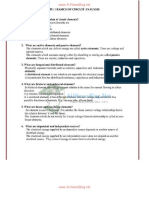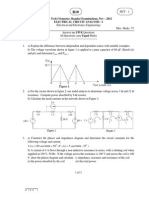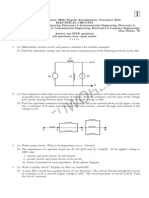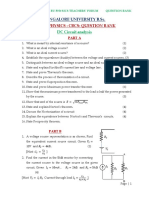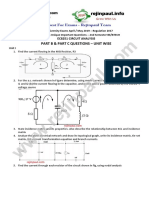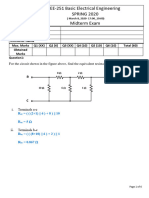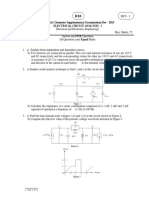0 ratings 0% found this document useful (0 votes) 80 views 14 pages Circuit Analysis
The document outlines a series of exercises and problems related to circuit analysis, focusing on DC circuits, network theorems, sinusoidal steady state analysis, and coupled circuits. It includes tasks such as calculating currents and resistances, applying Kirchhoff's laws, and deriving theorems like Thevenin's and Norton's. Additionally, it discusses concepts like resonance in RLC circuits and the characteristics of transformers.
Copyright
© © All Rights Reserved
We take content rights seriously. If you suspect this is your content,
claim it here .
Available Formats
Download as PDF or read online on Scribd
Go to previous items Go to next items
Save Circuit Analysis For Later @
0) Slip FefeidAccr
FB). dtl) poiless — V 4 Baksh;
7é8. itt! utgsis~ TF Snatatod'te.
VSB ENGINE
(An Autonomous Institution)
ERING COLLEGE, KARUR
DEPARTMENT OF ELECTRONICS AND COMMUNICATION ENGINEERING
1ECE/11 SEM
101 CIRCUIT ANALYSIS
PARTB&C
UNIT 1- DC CIRCUITS ANALYSIS
1. Find the current through each branch by network reduction technique.
2. Calculate a) the equivalent resistances across the tem
supplied by the source and c) power delivered to 16 ohm resistor in the cit
(page me ~ L103)
fot: PF (403+
ls of the supply, b) total current
cuit shows
pape nes
figure.
a)
Ip) f9.n- ‘14
2b
3. In the circuit shown, determine the current through the 2 ohm resist
delivered by the battery. Use Kirchhoff's laws.
for and the total current
(Page > = J-103)
: fb.
103�4. (i) Det
‘ine the current through 800 olin resistor in the network shown in figure, (8)
TB8: PRWe: (1032,
9.00. 7 waa,
5. (i) In the network shown below, find the current delivered by the battery. (10)
LBs
6. (i) Explain ; Kitehof? laws. (4) Depend:
diagrams. Voltage division and current div
terminals A ~B. (April/May 2022)
ions (2) with relevant @
sion rule (4) (i) Calculate the resistance between the
TE) £920 | yh
. Determine the value of V2 such that the current through the
impedance (344) ohm is zero.�8. i) Using the node voltage analysi
ohm resistances of
» find all the node voltages and currents in 1/3 ohm and V/5
7 Bl:
won (RN fou: I~ 4
wa
we on ma (2)a
|
plain the rules for constructing mesh impedance matrix and
ii) For the mesh-current analysis, ex
solving the matrix equation [Z]! = V.
2 9. Solve for VI and V2 using nodal method. Let V = 100V.
tit : Jl. PEM: 3.52
10. Using Mesh analysis, find current through 4 ohm resistor.
an ia
sf
2 | iKh— 08 TBI fae (- to
3�|. For the given circuit shown in figure, identify the values of currents in the various branches of ty.
circuit by using mesh. (Nov/Dec 2023) Ereuipes Aes)
> 20>
‘otal circuit resistance is 60 ©. Calculate the value of R. Ifthe supply voltage across the above circuit
is 60 V. find the current passin, through the individual resistance, (April/May 2023)
AL. 78 OF ae
14. Sate and explain kickoffs laws, (NovpDec 3022)
‘ne Ln, pI! .
15. List the difference between series and Parallel circuits, (Nov/Dec 2022)
TBP SBOP: 7a,
ye 7k Cornered
Ch Erplatrs Wie Coneep— dir Ynclepencleng Soumeer Wren it Ue
Sober ows Prate| (Wey (ree ~ aoaq) (Roary SMUD bp
1 2 .
(1. Find Pe Coreeeup Threw 5 est Ser by RR prone og SMPEX oa
Tnetens foe We CIEE hewn Lely (Niw/tee ~ Bea) (Rea)
RR RT Gamo 12. (094
ca We�2
UNIr2.
NETWORK THEOREM AND DUALITY
RK THEOREM AND DUALITY
i) Determine the Thevenin’s equivalent for the figure (8)
3K atin ga in, TE) 7% te: & Bp
soury
pa.
2 Derive expressions for star connected arms in terms of delta connected arms and delta connected
amss in terms of star connected arms. (16) TB/- fb: 2-8, a
3. Find the Thevenin’s equivalent circuit ofthe circuit shown below, to left ofthe terminals ab in
figure above. Then find the current through RL = 16 ohm and 36 ohm, (16) ge: PI%0 3-35
4. i) Find the current through branch a-b network using Thevenin’s theorem. (8)
te
ta
TBI [@: 3,35
Bun
ii) Find the current in each resistor using superposition principle of figure. (8)
toa sa.
Bi 3a 2sv�5:4) Determine the Thevenin’s equivalent citeuit, (8)
—t
“Poh
1h f.08 8p
fib
Hoo
(H) Determine the equivalent resistance across AR, ofthe citeuit shown in the figure below. (8)
te
it shown, use superposition theare
7. i) Compute the current in 23 ohm
below. (8)
ZX
Ti 000: bY
to compute current I
fa
Pie PP» 0 23
v)sev
2a
JA- FF. 228
an &
(it
Find the equivalent resis
mice between B and C in figure (8)�au
8. Using superposition theorer
™ calculate current through (243) ohm impedance branch of the
circuit shown,
50 an ee Tbl- PO: oF-042
wey Bon ea an
9. i) For the circuit shown, determine the Current in (2+j3) ohm by using superposition theorem, (8)
10 40
1
78)- 79° Seb 3
a 20.
mare
pa
{
il) State and prove Norton’s theorem. (8) f9- 2-40 (By)
10.i) Find the value of RL s
figure. (8)
© that maximum power is delivered to the load resistance shown in
on ton,
payin
(0% 57 let)
Re
ii) State and prove compensation theorem. (8)
11, Determine the maximum power delivered to the load in the circuit, (16)
fo: & (81)
12. Find the value of impedance Z so that maximum power will be transferred from source to load
for the circuit shown. (16)
ott PO PBL
vA
fa�"3.1 State and explain maximum power transfer theorem for variable Pure resistive load. (8)
i) Using Norton's theorem, find current through 6 ohm resistance shown in figure.
. pes
of
nv ton. Son
14. Analyze the su
PerPosition theorem, by finding the curent through the 20 resistor in the circuit,
(Nov/Dec 2023)
fh: 323 Cp)
No Ibe t 20d
1°. Draw the Thevenin’s and Norton's equivalent circuit a the terminals ab for the circuit shown in
figure. (April/may 2023) A” 232 Cy)
40 ra,
ae aml
R-2) , Que: 1 Agar pp�UNIT-3- § NUSOIDAL STEADY STATE ANALYSIS
|. Derive resonance frequency for series RLC circu 29-0 51) (BL
Derive Bandwidth fora series RLC cireuitas a function of resonant frequency
(6-5) GBs,
Derive expressions for the following in case of series resonant circuit. Resonant frequency,
Half Power frequencies quality fa
ictor and bandwidth. fo &/, =o Gx)
79 5 COBY)
ips for bandwidth and half power frequencies of RLC series
O07 Fl, sy GAY)
6. A series circuit consisting of a 12 Ohm resistor,
inductor is connected to a 100 V, 50 Hz source (a) For the condition of resonance, determine the
current and voltage drop across the inductor, (b) Determine the current and the voltage drop across
the inductor when this voltage drop isa maximum. 27. 99: S:/9- (By)
Tllustrate the expression for admittance in a parallel RLC circuits and discuss its variation with
frequency and the concept of resonance. (Nov/Dec 2023) 23, WM: £34 Cy)
8. In a RLC series circuits, the applied voltage is 5 V. Drops across the resistance and inductance
are 3 v and I v respectively. Caleulate the voltage across the capacitor. Draw the phasor
diagram (April/May 2023) (Nov/Dec 2022) (£2 > § 12 (7)
9. The following network is operating in a sinusoidal steady state supply. Find the Xt, Xo,
Impedance, current I, Power factor, Apparent power and Reactive power. (April/May 2023)
Explain the characteristics of RLC series resonant circuit
5. Explain and derive the relationshi
circuit,
a 84.4 micro Farad capacitor and a variable
20a o2n 130ur
F908 «8.88 Cop, |
c
230V, Sole
10. Outline the concept of super nodes in nodal analysis and how they are utilized to simplify
circuit analysis. Illustrate with an example. (Nov/Dee 2023)
[9° 0: [3% CBLS
We Tee tate hee dive Math Csi ae
Mrs U0 Lo! ond ye IHS) Pag
HEAD ieee en betentns TW Cerveay fire od Vote Aso Capac
cl pee
in Cy bebe, xu R :
wg se bur: NOM 8% ene 18. a 43
Reererde . ( wer lbet (2024
G02 13-4 (1) =�Explain the solution methodol
with step input.
Draw the voltage response across each element
constant DC voltage
RL series circuit, when it is subjected to
78. 0? 4.08, BY) rev trot Beary
4. Detive the DC response of
c sevies RLC circuit. Assume that inductance and capacitance are
initially uncharged.
f9: C4 %) Bw
5. Define time constant for RC circuit. yy, Ieee goay.
* Explain in detail about RL transients for applying AC input.
Explain in detail about RC transients for applying AC inpu. 77. 4.89
© Explain in detail bout RLC transients for applying AC input. cy
6. Der
rive the current i (t) for series RLC circuit when DC voltage is applied at =o. (7%. ZH
(as)
‘wansient current when an RC series circuit is excited by PG 4
Berg.
Determine the de response of RL and RC circuit and sketch the voltage transients, be,
72-44, 68 (By)
9. Define transient response and steady state response.
2 £3 ffl By) _.
10. What is transient? What is natural response? Sketch the DCfesponse of @ RLC circuit. S22L, A
1. A series RLC circuit has R= $00, L=0.2 H and C=50 uF. Constant voltage of 100 V is
impressed upon the circuit at t=0. find the expression for the vais current assuming initially
relaxed conditions. (Nov/Dec 2022) (Nov/Dec 2023) Lo (B
7 Tvewapayl. $45 (By
12. Explain parallel resonance and derive the resonance frequency. (April/may 2022)
13. Determine the time constant of a source free RU’ series circui Which power output is 100 W
at specific instant of time and changes by 30 W after I Second. (Nov/Dec 2023)
fe 43/
Cy)
7. Derive the expression for the
8
10�14. A series RLC circuit wth R=1000, L=
to it at t=0 through a switch, Find the
circuit conditions. (April/may 2023)
0.1 h and C=100 uF has a DC voltage of 200 V applied
© expression for the transient current. Assume initially reloxed
fo: 449 (By)
cle . iF
200v =
low
2g 16. For the RLC circuit shown, determine the impedance at a) resonant frequency b) 10Hz below
‘ resonant frequency ¢) 10 Hz above resonant frequency fi-00: 4.49 (7b)
122 O.15SH 22uF
055 FF
+S
. Vv
TD depermdne (re Tessrance Arey bee) ee
~-a
In whith RTD Pavtte) WAL RO. Moy foes Bed
in
I (Ras Dane: labs)�Unit-5- COUPLED CIRCUITS AND TOPOLOGY
—_——ELED CIRCUITS AND TOPOLOGY
1. Derive an expression for coefficient of coupling between two magn ically coupled coils, in
bL (By
(Nov /bee~ Qe
2 Derive the inductance value in two coils coupled in Parallel both for aiding and opposing
connections. po. be GB)
3. Give the relation between the self and mutual inductance of the coupled circuits. (9.2, (1 7a»
4. Explain in detail about network terminologies. 2g, f-L- (Br or
5: With neat sketch explain about ideal transformer. Z/- Ze F (By) we /be ~ Boks
: With neat sketch explain about linear transformer,(Nov/Dee 20rs) feet - be Be @)
7, Two identical coils A nad B of 1000 turns each lie in parallel planes such that 80% flux produced 9
terms of self-inductances and mutual inductance,
bY one coil links with other coi. A curent of % A flowing in col produces a flux of 0.05 mub in it.
TFs current in coil change from +12 A to 12 A in 0.02 se, calculate the mutual inductance and the
emf introduced in the cioil B. (April/may 2023) hth: $& C 7B),
8. Classify with an example of self and mutual inductance, (Nov/Dec 2023, AX 6-8/8
®, Explain the process of constructing a tree fora given electcal circuit and its role in simplifying
the analysis. (Nov/Dec 2023) KE t6 (By)
10. Construct the maximum possible mutual inductance of two inductively coupled coils, with self
inductance L1=25 mH, L2= 100 mH. (Nov/Dec 2023) 4d 8 By)
{i For the network given, draw the graph and tee. Show the link current, Write the tie-set
schedule for the tree , the equations for branch currents in terms Of link currents. Also write
independent equations. (Nov/Dec 2022) Rit. 72. By) v
x
a
11, With relevant diagrams explain the characteristics of an ideal transformer. (Apriv/may 2022)
2 © Bont baby, 195�12. For the electrical network shown in fig. Draw its topological graph and any four possible trees,
Ree gt Bi)
(April/may 2022
A Sa lomy a Vp 25-9> E&
a xr HG sup.
newer 2 bd aouee qe RE CEE
tremsienr” vetremms Cnov/ise~ 204)
Le cro Hf C2 KOMy
ree Cike]-
1B) Expaan IRE
' = Be,
circuiie Was REE
fe REE
~* i boy fs Tenpredics POF
nege ° se
ey jon Be eM presto Jor tne Reevaieins
=o. ae
ao F jemally re ered orem,
\
Crew/rec ~ 2024)
Quen SEMEN
dpe)
13�tO) Ree = Englaan eres) abou [i neore fromafonmer
Owed Yoleol deus sdornch )
iD Expladn tae Ate) bom ndestfane pvamiior ina
Kot, (new /Pee, ~ Qoda)
Ub frame MU Graph By Ha CiveE Siven and Meee debris Cit
Treielenee matndr aly ctyare ony sfouy Poseitete dowes of (HL Greys
a By
© Nw [pee - Qd2a
Ie
oe a, a
&>»
tr, Denove tae “Inopeclence, Md irbd pence , Wytorde| and “Romoendss160
Premier ob Oo de> Per Nema + (Iv fe ~ any)
)
wows \
SAP SG eduae Fhep










